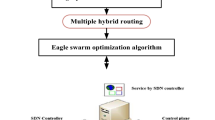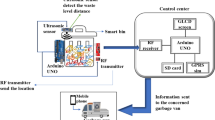Abstract
STDMA emerges as a promising channel access technique for providing Quality of Service (QoS) guarantees in multi-hop ad hoc networks such as community mesh and sensor networks. The contention-free channel access combined with spatial reuse of the channel provide significant benefits in the energy/throughput trade-off. On the other hand, the time-multiplexed communication introduces extra delay on the packets when relayed by intermediate nodes. Hence in large wireless sensor networks or mesh networks, where data is routed over several hops before reaching the data sink, STDMA protocols may introduce high end-to-end latency due to the reservation-based access policy. We argue that a suitable routing protocol specifically designed for reservation-based Medium Access Control (MAC) protocols can alleviate their high-latency drawback. Following this argument, we propose first such routing algorithms working on top of a generic STDMA MAC protocol. First, we consider routing with data fusion and present our GreenWave routing idea. We show that our algorithm significantly reduces the end-to-end delay when compared to routing over the shortest-hop paths. Second, we consider routing without data fusion, by taking into account the effect of congestion along the paths on the end-to-end delays. We provide a QIP formulation of the problem, and present a lower bound and a heuristic algorithm to bound the optimal solution. Based on the centralized heuristic algorithm, we propose a distributed, dynamic routing protocol GreenWave routing with Congestion and Flow control (GWCF), which uses a novel congestion and flow control technique utilizing the underlying contention-free protocol. We show by simulations that GWCF routing significantly improves the end-to-end delay while increasing the network throughput when compared to routing over shortest paths.
Similar content being viewed by others
References
Bruno, R., Conti, M., & Gregori, E. (2005). Mesh networks: Commodity multihop ad hoc networks. IEEE Communications Magazine, 43(3).
Allen, W., Martin, A., & Rangarajan, A. (2005). Designing and deploying a rural ad-hoc community mesh network testbed. In The IEEE Conference on Local Computer Networks (pp. 740–743).
Akyildiz, I. F., & Wang, X. (2005). A survey on wireless mesh networks. IEEE Communications Magzine, 43(9), s23–s30.
Wireless LAN Medium Access Control (MAC) and Physical Layer (PHY) Specifications, IEEE standards 802.11, January 1997.
Ye, W., Heidemann, J., & Estrin, D. (2004). Medium access control with coordinated, adaptive sleeping for wireless sensor networks. IEEE/ACM Transactions on Networking, 12(3), 493–506.
van Dam, T., & Langendoen, K. (2003). An adaptive energy-efficient MAC protocol for wireless sensor networks. In The First ACM Conference on Embedded Networked Sensor Systems (SenSys’03). Los Angeles, CA, November 2003.
Polastre, J., Hill, J., & Culler, D. (2004). Versatile Low Power Media Access for Wireless Sensor Networks (SenSys’04). Baltimore, Maryland.
MICA2: Wireless Measurement System, Crossbow Inc., http://www.xbow.com/
Rhee, I., Warrier, A., Aia, M., & Min, J. (2005). ZMAC: A Hybrid MAC for Wireless Sensor Networks (SenSys’05). San Diego, California, November 24.
Busch, C., Magdon-Ismail, M., Sivrikaya, F., & Yener, B. (2004). Contention-free MAC protocols for wireless sensor networks. In Proceedings of the 18th International Conference on Distributed Computing (DISC 2004) (pp. 245–259). Amsterdam, The Netherlands, October 2004.
Rajendran, V., Obraczka, K., & Garcia-Luna-Aceves, J. J. (2003). Energy-Efficient, Collision-Free Medium Access Control for Wireless Sensor Networks (SenSys’03). Los Angeles, California.
Bao, L., & Garcia-Luna-Aceves, J. J. (2001). A new approach to channel access scheduling for ad hoc networks. In Proc. ACM Mobicom. Rome, Italy, July 2001.
Ringwald, M., & Römer, K. (2005). BitMAC: A deterministic, collision-free, and robust MAC protocol for sensor networks. 2nd European Workshop on Wireless Sensor Networks (EWSN 2005), Istanbul, Turkey.
Herman, T., & Tixeuil, S. (2004). A distributed TDMA slot assignment algorithm for wireless sensor networks. ALGOSENSORS 2004, pp. 45–58.
Kalidindi, R., Ray, L., Kannan, R., & Iyengar, S. (2003). Distributed energy aware MAC layer protocol for wireless sensor networks. In Proc. International Conference on Wireless Networks (pp. 282–286).
Arisha, K. A., Youssef, M. A., & Younis, M. F. (2002). Energy-aware TDMA-based MAC for Sensor networks. IEEE Workshop on Integrated Management of Power Aware Communications, Computing and Networking (IMPACCT 2002), New York City, NY.
Sohrabi, K., & Pottie, G. (1999). Performance of a novel self-organization protocol for wireless ad-hocsensor networks. IEEE Vehicular Technology Conference, Amsterdam, The Netherlands, September 1999.
Arumugam, M., & Kulkarni, S. S. (2005). Self-stabilizing deterministic TDMA for sensor networks. In Proceedings of the second International Conference on Distributed Computing and Internet Technology (ICDCIT) (pp. 69–81), LNCS 3816. Bhubaneswar, India, December 22–24.
Rhee, I., Warrier, A., Min, J., & Xu, L. (2006). DRAND:: distributed randomized TDMA scheduling for wireless ad-hoc networks. In Proceedings of the Seventh ACM International Symposium on Mobile Ad Hoc Networking and Computing (pp. 190–201) (Florence, Italy, May 22–25, 2006), MobiHoc ’06. ACM Press, New York, NY.
Grönkvist, J. (2006). Novel assignment strategies for spatial reuse TDMA in wireless ad hoc networks. Wireless Networks, 12(2), 255–265.
Akyildiz, I. F., Su, W., Sankarasubramaniam, Y., & Cayirci, E. (2002). A survey on sensor networks. IEEE Communications Magazine, August 2002.
Li, C. S., Ofek, Y., & Yung, M. (1996). Time-driven priority flow control for real-time heterogeneous internetworking. In Proc. IEEE INFOCOM’96 (pp. 189–197).
Yemini, Y., & Florissi, D. (1993). Isochronets: A high-speed network switching architecture. In Proceedings of INFOCOM, IEEE. San Francisco, California, USA, April 1993.
Cormen, T. H., Leiserson, C. E., Rivest, R. L., & Stein, C. (2001). Introduction to algorithms (2nd ed., pp. 588–592). MIT Press.
Wang, Y., & Garcia-Luna-Aceves, J. J. (2004). Modeling of collision avoidance protocols in single-channel multihop wireless networks. Wireless Networks, 10(5), 495–506.
Cali, F., Conti, M., & Gregori, E. (2000). Dynamic tuning of the IEEE 802.11 protocol to achieve a theoretical throughput limit. IEEE/ACM Transactions on Networking, 8(6),785–799.
Takagi, H., & Kleinrock, L. (1984). Optimal transmission range for randomly distributed packet radio terminals. IEEE Transactions on Communications, 32(3), 246–257.
Wu, L., & Varshney, P. (1999). Performance analysis of CSMA and BTMA protocols in multihop networks: (i) Single channel case. Information Sciences, 120, 159–177.
CPLEX Mathematical Programming Optimization Software, ILOG Inc, http://www.ilog.com/products/cple
Tassiulas, L. (1995). Adaptive back-pressure congestion control based on local information. IEEE Transactions on Automatic Control, 40(2), 236–250.
Author information
Authors and Affiliations
Corresponding author
Rights and permissions
About this article
Cite this article
Sivrikaya, F., Yener, B. Minimum delay routing for wireless networks with STDMA. Wireless Netw 15, 755–772 (2009). https://doi.org/10.1007/s11276-007-0073-2
Published:
Issue Date:
DOI: https://doi.org/10.1007/s11276-007-0073-2




